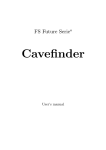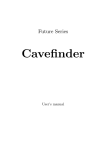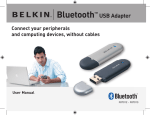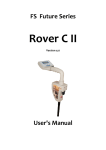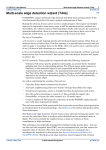Download Cavefinder
Transcript
Future Series Cavefinder 8 User’s manual 10th January 2005 User’s manual: Cavefinder 2 Any information contained in these operating instructions may be changed without prior notice. OKM does not make any warranty for this document. This also applies without limitation to implied assurances of merchantability and fitness for a specific purpose. OKM does not assume any responsability for errors in this manual or for any incidental or consequential damage or loss associated with the delivery, exploitation or usage of this material. This documentation is available as presented“ and without any kind of warranty. In no circumstances OKM ” takes responsibility for lost profits, usage or data losts, interruption of business activities or all kind of other indirectly damages, which developed because of errors in this documentation. This instruction manual and all other stored media, which are delivered with this package should only be used for this product. Program copies are allowed only for security- and savety purposes. The resale of these programs, in original or changed form, is absolutely forbitten. This manual may not be copied, duplicated or translated into another language, neither in part nor completely, over the copyright matters without the prior written consent of OKM. Copyright © 2005 OKM Ortungstechnik GmbH. All rights reserved. Table of Contents 3 Table of Contents 1 Important Notes 1.1 General Notes . . . . . . 1.2 Possible Health Hazards 1.3 Surrounding Area . . . . 1.4 Voltage . . . . . . . . . 1.5 Data safety . . . . . . . . . . . . 5 5 5 5 6 6 2 Technical Specifications 2.1 Control Unit . . . . . . . . . . . . . . . . . . . . . . . . . . . . . . . . . . . . . . 2.2 Data Transmission . . . . . . . . . . . . . . . . . . . . . . . . . . . . . . . . . . . 2.3 Computer, Minimum Requirements . . . . . . . . . . . . . . . . . . . . . . . . . . 7 7 7 8 3 Scope of Delivery 9 . . . . . . . . . . . . . . . . . . . . . . . . . . . . . . . . . . . . . . . . . . . . . . . . . . . . . . . . . . . . . . . . . . . . . . . . . . . . . . . . . . . . . . . . . . . . . . . . . . . . . . . . . . . . . . . . . . . . . . . . . . . . . . . . . . . . . . . . . . . . . . . . . . . . . . . . . . . 4 Assembly 11 5 Installation of Radio Transmission 5.1 Windows 98 . . . . . . . . . . . . . 5.2 Windows XP . . . . . . . . . . . . 5.2.1 Service Pack 1 . . . . . . . 5.2.2 Service Pack 2 . . . . . . . 5.3 Software & Install driver . . . . . . 5.4 Software Configuration . . . . . . . 5.5 Configurate connection . . . . . . . . . . . . . . 12 12 12 12 12 15 16 18 6 Control Elements 6.1 Front View . . . . . . . . . . . . . . . . . . . . . . . . . . . . . . . . . . . . . . . 6.2 Back View . . . . . . . . . . . . . . . . . . . . . . . . . . . . . . . . . . . . . . . . 6.3 Touchpad for Menu Navigation . . . . . . . . . . . . . . . . . . . . . . . . . . . . 20 20 21 22 7 Detection of Cavities 23 8 Loading the Device 25 9 Danger of Explosion during Excavation 26 10 Maintenance and Services 27 . . . . . . . . . . . . . . . . . . . . . . . . . . . . . . . . . . . . . . . . . . . . . . . . . . . . . . . . . . . . . . . . . . . . . . . . . . . . . . . . . . . . . . . . . . . . . . . . . . . . . . . . . . . . . . . . . . . . . . . . . . . . . . . . . . . . . . . . . . . . . . . . . . . . . . . . . . . . . . . . . . . . . . . . . . . . . . . User’s manual: Cavefinder 4 List of Figures 1 2 3 4 5 6 7 8 9 10 11 12 13 14 15 16 17 18 19 20 21 22 23 24 Scope of Delivery . . . . . . . . . . . . . . . . . . Connection of Electrodes . . . . . . . . . . . . . . Connection of USB Dongle . . . . . . . . . . . . Recognition of a new hardware in Service Pack 1 Recognition of a new hardware in Service Pack 2 Equipment manager in Windows XP . . . . . . . Hardware update assistent in Windows XP . . . Select a driver in Windows XP . . . . . . . . . . Device driver searching dialog in Windows XP . Bluetooth installation . . . . . . . . . . . . . . . Bluetooth installation . . . . . . . . . . . . . . . Bluetooth configuration assistent . . . . . . . . . Bluetooth configuration assistent . . . . . . . . . Determining the given COM-Port . . . . . . . . . . . . . . . . . . . . . . . . . . . . . . . . . . . . . . . . . . . . . . . . . . . . . . . . . . . . . . . . . . . . . . . . . . . . . . . . . . . . . . . . . . . . . . . . . . . . . . . . . . . . . . . . . . . . . . . . . Front View . . . . . . . . . . . . . . . . . . . . . Back View . . . . . . . . . . . . . . . . . . . . . . Touchpad for Menu Navigation . . . . . . . . . . Connection of Electrodes . . . . . . . . . . . . . . Rarefy a Measurement . . . . . . . . . . . . . . . Connection of Charger . . . . . . . . . . . . . . . . . . . . . . . . . . . . . . . . . . . . . . . . . . . . . . . . . . . . . . . . . . . . . . . . . . . . . . . . . . . . . . . . . . . . . . . . . . . . . . . . . . . . . . . . . . . . . . . . . . . . . . . . . . . . . . . . . . . . . . . . . . . . . . . . . . . . . . . . . . . . . . . . . . . . . . . . . . . . . . . . . . . . . . . . . . . . . . . . . . . . . . . . . . . . . . . . . . . . . . . . . . . . . . . . . . . . . . . . . . . . . . . . . . . . . . . . . . . . . . . . . . . . . . . . . . . . . . . . . . . . . . . . . . . . . . . . . . . . . . . . . . . . . . . . . . . . . . . . . . . . . . . . . . . . . . . . . . . . . . . . . . . . . . . . . . . . . . . . . . . . . . . . . . . . . . . . . . . . . . . . . . . . . . . . . . . . . . . . . . . . . . . . . . . . . . . . . . . . . . . . . . . . . . . . . . . . . . . . . . . . . . . . . . . . . . . 10 11 11 12 13 13 14 14 15 15 16 17 17 18 18 19 19 19 20 21 22 23 24 25 Technical Specifications (Control Unit) . . . . . . . . . . . . . Technical Specifications (Data Transmission) . . . . . . . . . Technical Specifications (Computer, Minimum Requirements) Scope of Delivery . . . . . . . . . . . . . . . . . . . . . . . . . . . . . . . . . . . . . . . . . . . . . . . . . . . . . . . . . . . . . . . . . . . . . 7 7 8 9 List of Tables 1 2 3 4 1 Important Notes 1 5 Important Notes Please read these operating instructions carefully and closely before using Cavefinder and its accessories! These instructions give information on how to use the device and point out potential sources of danger. Cavefinder and its accessories serves for documentation and analysis of detect objects deposited and changes performed in the ground. The registered data of the ground structure will be transmitted to a PC for visual representation in a special software program using the components we offer. Any additional notes relating to this has to be observed. Please read attentively the manual according to the software you are using! 1.1 General Notes Being an electronic device, Cavefinder has to be treated with the caution and care necessary when such devices are used. Any failure to observe the safety precautions given or any use for purposes other than the ones it is conceived for may result in a damage or destruction of the processing unit and connected components. The device will get destroyed if it is opened improperly. 1.2 Possible Health Hazards If used properly the device normally does not pose any health hazards. According to current scientific knowledge, the high-frequency signals are not harmful to the human body on account of their low power. 1.3 Surrounding Area Having been transferred from a cold to a warmer place, the device should not be operated immediately afterwards. Any condensation, which may have formed, might cause the device to get destroyed. Avoid strong magnetic fields, which may occur in places such as near machines or loudspeakers, and avoid using a detector within a radius of 50 meters. Metallic objects on the ground such as cans, doses, catches, nails, screw or others can influence negatively your measurement and have to be removed. Also you have to remove keys, telephones, chains and rings and all other magnetic and metallic objects from yourself. User’s manual: Cavefinder 1.4 6 Voltage The power supply should not be outside the indicated range of values. Only use batteries and rechargable batteries. Never use the 230 Volt mains supply. 1.5 Data safety There can be errors in the process of data collection if • the range of the sender module is been exceeded, • the power supply of the device is to low, • the cables you are using are to long, • other electronic devices sends out disturbances or • atmospherics occurs (lightnings, . . . ). 2 Technical Specifications 2 7 Technical Specifications The following technical indications are medial values. During operation small variations are quite possible. 2.1 Control Unit Dimensions (H x W x D) . . . . . . . . . . . . . . . . . . . . . . . . . . . . . . . . . . . 430mm x 150mm x 260mm Weight . . . . . . . . . . . . . . . . . . . . . . . . . . . . . . . . . . . . . . . . . . . . . . . . . . . . . . . . . . . . . . . . . . . . . . about 3kg Voltage . . . . . . . . . . . . . . . . . . . . . . . . . . . . . . . . . . . . . . . . . . . . . . . . . . . . . . . . . . . . . . . . . . . . . . . . 12 VDC Processor . . . . . . . . . . . . . . . . . . . . . . . . . . . . . . . . . . . . . . . . . . . . . . . . . . . . . . . . . . . . . Motorola, 4 MHz Operating Temperature Storage Temperature Air Humidity Waterproof . . . . . . . . . . . . . . . . . . . . . . . . . . . . . . . . . . . . . . . . . . . . . . . . . . . . . 0℃ – 50℃ . . . . . . . . . . . . . . . . . . . . . . . . . . . . . . . . . . . . . . . . . . . . . . . . . . . . . . -20℃ – 60℃ . . . . . . . . . . . . . . . . . . . . . . . . . . . . . . . . . . . . . . . . . . . . . . . . . . . . . . . . . . . . . . . 5% – 75% . . . . . . . . . . . . . . . . . . . . . . . . . . . . . . . . . . . . . . . . . . . . . . . . . . . . . . . . . . . . . . . . . . . . . . . . . No Maximal Penetration Depth . . . . . . . . . . . . . . . . . . . . . . . . . . . . . . . . . . . . . . . . . . . about 40 meters Table 1: Technical Specifications (Control Unit) 2.2 Data Transmission The following specifications of data transmission are only valid for the model Cavefinder B. The Cavefinder A does not have a data transmission. Technology . . . . . . . . . . . . . . . . . . . . . . . . . . . . . . . . . . . . . . . . . . . . . . . . . . . . . . . . . . . . . . . . . . Bluetooth Frequency . . . . . . . . . . . . . . . . . . . . . . . . . . . . . . . . . . . . . . . . . . . . . . . . . . . . . . . . . . . . 2.4 – 2.4835 GHz Maximal Data Transmission Rate Receiving Sensitivity Maximal Range . . . . . . . . . . . . . . . . . . . . . . . . . . . . . . . . . . . . . . . . . . . . . . 1 Mbps . . . . . . . . . . . . . . . . . . . . . . . . . . . . . . . . . . . . . . . . . . . . . . . . . . . . . . . . . . -85 dBm . . . . . . . . . . . . . . . . . . . . . . . . . . . . . . . . . . . . . . . . . . . . . . . . . . . . . . about 100 meters Table 2: Technical Specifications (Data Transmission) User’s manual: Cavefinder 2.3 8 Computer, Minimum Requirements The computer is not part of the scope of delivery. The indicated values should help you for a correct selection of a suitable computer for analysis of your measured results. A computer is only necessary for the usage of Cavefinder B. The model Cavefinder A does not provide data transmission to pc. CD-ROM Drive . . . . . . . . . . . . . . . . . . . . . . . . . . . . . . . . . . . . . . . . . . . . . . . . . . . . . . . . . . . minimum 4x COM-Port (Data Transmission) Free Memory . . . . . . . . . . . . . . . . . . . . . . . . . . . . . . . . . . . . . . . . . . . . . . . . . . . . . . . . . minimum 20 MB Working Memory (RAM) Graphic Card . . . . . . . . . . . . . . . . . . . . . . . . . . . . . . . . . . . . . . . . . . . . . . . . . . . USB . . . . . . . . . . . . . . . . . . . . . . . . . . . . . . . . . . . . . . . . . . . . minimum 128 MB . . . . . . . . . . . . . . . . . . . . . . . . . . . . . . . . . . . minimum 64 MB, OpenGL-compatible Operating System . . . . . . . . . . . . . . . . . . . . . . . . . . . . . . . . . . . . . . . Windows 98SE, Me, 2000, XP Table 3: Technical Specifications (Computer, Minimum Requirements) 3 3 Scope of Delivery 9 Scope of Delivery In the following section you can find all standard equipment. The scope of delivery can be different in some circumstances because of some optional accessories which should not be included in the basic equipment. 1 Control Unit 4 Electrode (with about 20m cable) 1 User’s Manual 1 Charger for Control Unit 1 Carrying Case 1 3D Software ( standard )* 1 USB Bluetooth Dongle* 1 USB Extension Cable* 1 USB Setup CD* * only Cavefinder B; Table 4: Scope of Delivery Beware that pictures in this manual could be different to delivered parts. User’s manual: Cavefinder 10 Control Unit Electrode USB Bluetooth Dongle * USB Extension Cable * Charger for Control Unit Figure 1: Scope of Delivery 4 4 Assembly 11 Assembly In this section is explained how to assemble the device and how to prepare a measurement. Figure 2: Connection of Electrodes In figure 2 you can see how to connect the electrodes to the device in the right way. Do it without any unnecessary application of force! The detailed discription how to connect the electrodes you can find in section 7 on page 23. Figure 3: Connection of USB Dongle With the model Cavefinder B you have the possibility to transfer all measured values to a computer. In figure 3 you can see, how to connect the Bluetooth Dongle with the USB-Port of your computer. Further information about the correct utilisation and installation of the USB driver you can find in section 5 on page 12. User’s manual: Cavefinder 5 12 Installation of Radio Transmission This section describes the installation of the USB Bluetooth Dongle. According to your operating system, please follow the instructions in the appropriate subsection. Consider that the represented figures not necessarily agree with the current version of your operating system or the version of your USB installation. 5.1 Windows 98 In Windows 98 there are no special preparations necessary to install the USB Dongle. Please go on to section 5.3. 5.2 Windows XP Plug in the USB Dongle, which is delivered with the measuring instrument, in a free USB port of your PC. If a dialog like in figure 4 appears on your screen, than please read attentively section 5.2.1, if not please go on to section 5.2.2! Figure 4: Recognition of a new hardware in Service Pack 1 5.2.1 Service Pack 1 Click Cancel in the dialog of figure 4 and finish this procedure. Please go on in section 5.3. 5.2.2 Service Pack 2 If a dialog like in figure 4 does not appear on your screen, than at least you should see a small symbol like figure 5 in the lower right side of your screen. Please wait until this automatic installation is finished completely and the following message, which is represented in figure 5 appears on your screen. 5 Installation of Radio Transmission 13 Figure 5: Recognition of a new hardware in Service Pack 2 Now install software and driver like it is explained in section 5.3 and further read attentively the following section! After finished your complete installation of software and driver, you have to do some manual changes inside your system. Therefore click Start → Control Panels → System. Click inside the data sheet Hardware on Equipment Manager. A new window will open, where you can find a category named Bluetooth Radio Instruments and inside this file there is an entry Generic Bluetooth Radio. It is represented in figure 6. Figure 6: Equipment manager in Windows XP Click on this entry with the right mouse button and select Drivers update from this menu. A dialog like represented in figure 7 appears, where you have to select the entry No, not this time and confirm your input by a click on OK. Another dialog will open, where you please select the entry Install software from a list . . . and also confirm by a click on OK. User’s manual: Cavefinder 14 Figure 7: Hardware update assistent in Windows XP In the next dialog select the entry No search, select driver individually and confirm by a click on OK. Now the dialog from figure 8 should appear on your screen. Figure 8: Select a driver in Windows XP Click in this dialog on Data carrier and a new window will open, which is represented in figure 9. Click on Search and select the directory Software\BTW inside your Bluetooth-CD. A list including all available files will appear on your screen where you have to select the file BTWUSB.INF and confirm by a click on Open. 5 Installation of Radio Transmission 15 Figure 9: Device driver searching dialog in Windows XP Then please click on Next and Finish, to finish the installation. Now go on in section 5.4, to configurate the Bluetooth connection. 5.3 Software & Install driver Now it is time to install the software and driver on your system. Therefore you have to insert your Bluetooth CD into the CD ROM drive of your computer. If the CD does not start automatically, please double click on Desktop and then double click on the symbol of your CD ROM drive. With a further double click on file setup.exe you start the installation. Figure 10: Bluetooth installation User’s manual: Cavefinder 16 The first window of your installation will open. Click here on the entry Dongle BTW 1.4.2.10 and follow the instructions on the screen. If a dialog like in figure 11 appears (depending on the configuration of the system and the installed service pack), click on Driver mark, and a new window will open. This is also represented in the figure. Mark here the entry Ignore and then go on by a click on OK of both dialog windows. Figure 11: Bluetooth installation Now please wait until the installation is finished and all data is transmitted to your computer. If necessary you can reload the computer now. If you have Windows XP with Service Pack 2, then please finish to read the instructions in section 5.2.2, if not so please go on with the following section. 5.4 Software Configuration If the installation is finished successfully you will find on your desktop the Bluetooth symbol. Double click on this symbol to start the configuration. Continue to click on Next until a dialog like in figure 12 appears on your screen. 5 Installation of Radio Transmission 17 Figure 12: Bluetooth configuration assistent Deactivate every option except Bluetooth Serial Port. This option is neccessary for the data transmission from your measuring instrument to the software. Continue by a click on Next. Figure 13 shows the dialog window which is following. Figure 13: Bluetooth configuration assistent Click on Skip and then on Finish, to finish the configuration. configurated. Now your USB Dongle is To find out on which COM-Port your Bluetooth connection is been installed, click with the right mouse button on your Bluetooth symbol in the lower right side of your screen and select the menu option Advanced Configuration. A dialog will open like represented in figure 14. User’s manual: Cavefinder 18 Figure 14: Determining the given COM-Port You can find on the data sheet Local Services the indication Bluetooth Serial Port, which indicates on which COM-Port the connection is been installed. This COM-Port you have to indicate for every data transfer to your software. 5.5 Configurate connection After installation and configuration of your Bluetooth connection you should test if the data transmission from your measuring instrument to the computer is working correctly. Be sure that the USB Dongle is attached to your computer. Take your measuring instrument and power on the device. Select a operating mode, which includes the direct data transmission to PC. Additional information on direct data transmission to PC you can find in section 7 on page 23. Figure 15: As soon as you confirm your selected operating mode the device will try to get a radio connection to the computer. If this connection is successful a message like in figure 15 appears. 5 Installation of Radio Transmission 19 Figure 16: Click with your mouse inside this message. The dialog from figure 16 will open. In this dialog you have to enter OKM. It is neccessary to write in capital letters! Figure 17: In the first connection establishment a message like in figure 17 will appear on your screen. Click inside this message and mark in the following dialog this option Always allow this device to access this service. Figure 18: This marks saves the indications you made, so you don‘t have to enter all information again in the system. Now you have finished the configuration and installation of your Bluetooth radio transmission. User’s manual: Cavefinder 6 20 Control Elements In this section you will learn more about the fundamental use of all control elements for this measuring instrument. All connections, inputs and outputs are explained in detail. 6.1 Front View Figure 19 shows the front side of the device. Operating Lamp LCD Display Power On and Off Button Connection of Charger Figure 19: Front View The Power On and Off Button is used to switch on and off the control unit. Before operating with your device you have to be sure that the device is charged. The Operating Lamp shines, when the device is powered on and indicates the operating readiness of the control unit. The LCD Display indicates how often the device was powered on. This display is only of interest for the repair and maintenance service. The Connection of Charger is used to connect the delivered charger to the control unit if you want to load the internal battery of the device. 6 Control Elements 6.2 21 Back View Figure 20 shows the back side of the control unit with all connections. Connection for Electrodes Antenna for Bluetooth Figure 20: Back View The Connection for Electrodes is used to connect the delivered electrodes for cavity detection. The Antenna for Bluetooth is used for the data transmission to a connected pc and exists only for Cavefinder B. User’s manual: Cavefinder 6.3 22 Touchpad for Menu Navigation The top of the device is including a touchpad like in figure 21. The represented buttons have no particular use in both models of the Cavefinder and are not necessary for operating the device. LCD Display No Function No Function No Function Figure 21: Touchpad for Menu Navigation 7 7 Detection of Cavities 23 Detection of Cavities The Cavefinder offers you a geo-electrical measuring method to detect all kind of cavities. The device is not able to determine the exact depth of a located cavity. There are four connections for the electrodes on the control unit. You have to keep a certain manner to connect the electrodes in the right way. The correct connection is represented in figure 22. Figure 22: Connection of Electrodes Try to define a square area with the four electrodes and connect the cables to the main unit. Therefore you have to plug in the electrode cable of the upper left electrode in the first connection of the device from left to right. The following electrode cable which is placed next to it counter clockwise has to be plugged into the next connection. Go on in the same direction until all electrodes are connected. To perform a measurement plug in the electrodes like explained above and connect them in the correct way. Power on the device and wait until the result is represented on the display. If a cavity is been detected inside your defined area the message Cave = Yes appears on the display, if there is no cavity the message Cave = No will be shown. If this is your first measurement it is adviced to define a wide area to find out in generally if User’s manual: Cavefinder 24 there is a cavity or not. To detect the exact location of a cavity (if a cavity exists) split your measured field in four smaller parts and repeat the measurement in every subsection. This method you can repeat as often as you like until you found the exact location of the cavity. Figure 23: Rarefy a Measurement In figure 23 the explained measuring method is represented once again. At first measure the wide area which is here represented in black color. On the display of the device the message Cave = Yes appears. Then devide this area in four smaller subsections and repeat your measurement inside these red represented fields again. Only in the upper left field the result Cave = Yes will be shown. All other fields will indicate the message Cave = No on the display. Now you can split this red marked subsection again to specify the position and size of the detected cavity. With model Cavefinder B additionally you can transfer data to a connected computer. The measured data will only be transferred to a pc if the result is Cave = Yes. As a correct number of impulses you have to enter 4 when you prepare the software program. Further information about the software you can find in the appropriate user’s manual for software! 8 8 Loading the Device 25 Loading the Device Before you start a measurement please control if the Cavefinder is charged completely. The following section describes how to load the Cavefinder in a correct way. To load the internal battery of the device use only the delivered charger. Figure 24: Connection of Charger Figure 24 shows how to connect the delivered charger to the Cavefinder. Therefore you have to use the appropriate connection at the front side of the device. A control lamp on the charger lights up in green during the loading procedure and signal the current loading of the Cavefinder. Only if the lamp stops shining the loading procedure is finished. The loading time in case of complete discharge of the device is about 8 – 12 hours. User’s manual: Cavefinder 9 26 Danger of Explosion during Excavation Unfortunately, the last two world wars also made the ground in many places of the world a potentially explosive scrap heap. A host of those lethal relics are still buried in the ground. Do not start digging and hacking for an object wildly when you receive a signal of a piece of metal from your device. Firstly, you might indeed cause irreparable damage to a truly rare find, and secondly, there is a chance that the object reacts in an insulted way and strikes back. Note the colour of the ground close to the surface. A red or reddish color of the ground is an indicator of rust traces. As regards the finds themselves, you should definitely pay attention to their shape. Curved or round objects should be a sign of alarm, especially if buttons, rings or little pegs can be identified or felt. The same applies to recognizable ammunition or bullets and shells. Leave that stuff where it is, do not touch anything and, most importantly, do not take any of it home with you. The killing machines of war made use of diabolical inventions such as rocker fuses, acid fuses and ball fuses. Those components have been rusting away in the course of time, and the slightest movement may cause parts of them to break and be triggered. Even seemingly harmless objects such as cartridges or large ammunition are anything but that. Explosives may have become crystalline over time, that is, sugar-like crystals have formed. Moving such an object may cause those crystals to produce friction, leading to an explosion. If you come across such relics, mark the place and do not fail to report the find to the police. Such objects always pose a danger to the life of hikers, walkers, farmers or children. 10 10 Maintenance and Services 27 Maintenance and Services In this section you will learn how to maintain your measuring instrument with all included accessories to keep it in good condition a long time and to get good measuring results. The following list indicates what you absolutely should avoid: • penetrating water • strong dirt and dust deposits • hard impacts • strong magnetic fields • high and long lasting heat effect If you want to clean your device please use a dry rag of soft material. To avoid any damage you should transport the device and accessories always in the appropriate carrying cases. Beware that all batteries and accumulators are always charged fully while operating with your system. You should only load the batteries when they are completely discharged no matter if you are working with the external power supply or with the internal accumulators. In this way a long durability of the used batteries is guaranteed. To load the external and internal batteries you have to use only chargers which are part of our scope of delivery. Index Bluetooth, 12 Dongle, 12 USB, 12 28




























